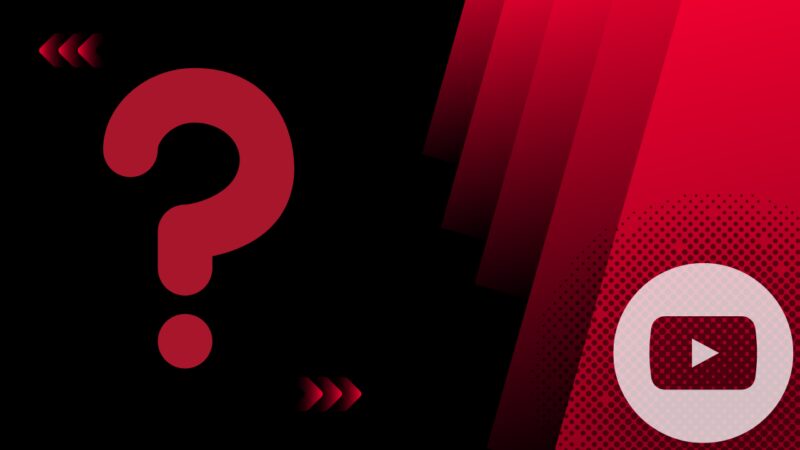Ah, the digital age – a time when streaming videos has become an integral part of our daily lives. Yet, there’s nothing more frustrating than clicking on a YouTube video, only to find it refuses to play. Fear not, for we have compiled 8 foolproof ways to fix this aggravating issue! In this article, we’ll dive into these solutions, ensuring you’re back to binge-watching your favorite content in no time.
At times, solutions can be as simple as a quick browser refresh. Other instances? Well, they might require a deeper dive into the labyrinth of technical settings. Regardless, we’ve got you covered. From clearing your cache to updating your software, these tips are bound to get your videos playing smoothly again. So, let’s embark on this troubleshooting journey and put an end to those pesky playback problems once and for all!
Before we dive into the problems of Youtube, take some time to check out our article on the best adventure game frenchises in order by release date.
1. Refresh the Page
It’s astonishing how often the simplest of solutions can save the day. Need proof? Look no further than refreshing your browser page. This quick fix can work wonders, especially if you’re dealing with temporary glitches or server hiccups. But wait, there’s more! Let’s dig into the nitty-gritty of this technique:
- Step 1: Locate the refresh button – typically found in the top-left corner of your browser window. You’ll spot a circular arrow, beckoning you to give it a click. Alternatively, pressing the F5 key on your keyboard will do the trick as well.
- Step 2: Patience is a virtue, dear reader. Give the page a moment to reload. You’ll witness the URL bar dancing with excitement, as the process unfolds before your very eyes.
- Step 3: The moment of truth! Once the page has reloaded, check if the video plays without a hitch. Should the issue persist, don’t fret. We’ve got a plethora of other tricks up our sleeves.
There you have it – a refreshingly simple method that might just breathe new life into your YouTube video playback experience. And remember, when all else fails, sometimes the best thing to do is start anew.
2. Check Your Internet Connection

Ever encountered a scenario where everything comes to a grinding halt, leaving you to wonder, “Is it just me, or…?” In the realm of YouTube videos, a flaky internet connection might be the culprit. Fear not, for we’ve got your back with a step-by-step guide to get you back on track:
- Step 1: First, let’s get down to basics. Check your device’s connection to the internet – be it Wi-Fi or a wired Ethernet connection. A simple way to do this is to try loading another webpage or streaming content on a different platform. If all’s well, then we march on.
- Step 2: If you’re on Wi-Fi, examine the signal strength. Is it weaker than a cup of decaf coffee? That might be the issue. Consider relocating closer to the router or investing in a Wi-Fi extender to bolster your connection.
- Step 3: Still no luck? Perhaps your modem and router could use a breather. Unplug them for a minute, and then plug them back in. This reboot process might just work its magic.
- Step 4: When all else fails, it’s time to call in the cavalry – your internet service provider (ISP). They can diagnose any lingering connection issues and help resolve them.
Armed with this knowledge, you’re now equipped to tackle any internet-related obstacles standing in the way of your video-streaming escapades. Good luck, and happy troubleshooting!
3. Clear Cache and Cookies
What if we told you that a sneaky little duo called cache and cookies could be behind your YouTube playback woes? Over time, these digital crumbs can pile up, causing a ruckus in your browser. Fear not – we’ve got the lowdown on how to evict them from Chrome and Firefox:
For Google Chrome:
- Click the three vertical dots in the top-right corner of your browser window, and select Settings from the drop-down menu.
- Scroll down to the Privacy and Security section, and then click on Clear browsing data.
- In the pop-up window, ensure the boxes for Cookies and other site data and Cached images and files are ticked.
- Choose a time range – we recommend selecting All time for a thorough cleanse.
- Hit the Clear data button, and voilà! Your browser should now be squeaky clean.
For Mozilla Firefox:
- Click the three horizontal lines (a.k.a. the hamburger menu) in the top-right corner, and then choose Options.
- Select the Privacy & Security tab on the left-hand side of the screen.
- Under the Cookies and Site Data section, click on the Clear Data… button.
- Make sure both Cookies Site Data and Cached Web Content are checked.
- Press the Clear button, and your Firefox browser should now be free of cache and cookie clutter.
Now that you’ve cleared away the digital debris, go ahead and give that YouTube video another whirl. With any luck, your playback troubles will be a thing of the past. Happy streaming!
4. Update Your Browser
Outdated browsers can be a recipe for disaster when it comes to smooth video playback. By updating to the latest version, you’ll not only improve your YouTube experience but also enhance your browser’s overall performance and security. Here’s a step-by-step guide to updating Google Chrome and Mozilla Firefox:
For Google Chrome:
- Click on the three vertical dots in the top-right corner of your browser window to open the menu.
- Hover your cursor over Help and then select About Google Chrome from the side menu that appears.
- Chrome will now automatically check for updates. If an update is available, it’ll begin downloading it.
- Once the update is complete, you’ll be prompted to relaunch your browser. Click Relaunch to apply the update and restart Chrome.
For Mozilla Firefox:
- Click the three horizontal lines (the hamburger menu) in the top-right corner of the browser window.
- Choose Help from the drop-down menu and then click on About Firefox.
- Firefox will automatically search for updates. If one is found, it will start downloading.
- After the update is downloaded, click Restart to Update Firefox to apply the changes and reboot your browser.
With your browser now updated to the latest and greatest version, given that YouTube video another shot. Chances are, you’ll be streaming seamlessly and enjoying the benefits of a more secure and efficient browser. Happy browsing!
5. Disable Browser Extensions
While browser extensions can be incredibly useful, they can also play the role of the uninvited guest at your YouTube playback party. Fear not, for we have a step-by-step guide to help you identify and disable these potential party-crashers:
- Open your browser’s extensions page: In Chrome, click the three vertical dots in the top-right corner, hover over More tools, and select Extensions. For Firefox, click the three horizontal lines (the hamburger menu) in the top-right corner and choose Add-ons and Themes, then click on Extensions in the left-hand menu.
- Examine your extensions: Take a close look at the list of installed extensions. Keep an eye out for any that may interfere with video playbacks, such as ad blockers, privacy tools, or script blockers.
- Disable extensions one by one: To test whether an extension is causing the issue, disable it by toggling the switch in Chrome or clicking the Disable button in Firefox. After disabling an extension, refresh your YouTube video to see if playback improves.
- Identify the culprit: If disabling an extension resolves the issue, you’ve found the source of the problem! You can either keep the extension disabled, look for an alternative, or contact the extension’s developer for assistance.
- Re-enable the innocent: Don’t forget to re-enable any extensions that weren’t causing issues to ensure your browser is functioning at its best.
With those pesky extensions out of the way, your YouTube video playback should be smooth sailing. Now, sit back, relax, and enjoy your favorite content without any interruptions!
6. Update Your Device’s Software
Outdated device software can throw a wrench in your YouTube video playback experience. Fear not, for we have a step-by-step guide to help you update your device’s software, ensuring a smooth and seamless viewing experience:
For Windows:
- Press the Windows key on your keyboard, and type “update” in the search bar. Click on Check for updates from the search results.
- In the Windows Update settings, click on the Check for updates button.
- If updates are available, Windows will automatically download and install them. You may need to restart your computer to apply the updates fully.
For macOS:
- Click on the Apple menu in the top-left corner of your screen, and then select System Preferences.
- Click on Software Update to check for available updates.
- If an update is available, click on the Update Now button to download and install it. You may need to restart your Mac to complete the update process.
For Android:
- Open the Settings app on your device and scroll down to find System or About Phone.
- Tap on Software Update or System Update to check for available updates.
- If an update is available, follow the on-screen instructions to download and install it. Your device may restart during the update process.
For iOS:
- Open the Settings app on your device, and then tap on General.
- Select Software Update to check for available updates.
- If an update is available, tap on Download and Install to begin the process. Your device may restart to apply the update fully.
With your device’s software now up to date, you should enjoy a more seamless YouTube video playback experience. Now, dive into the world of video content without any hiccups!
7. Adjust the Video Quality
Sometimes, the culprit behind your YouTube woes could be the video quality setting. If your internet connection is not robust enough to handle high-definition or 4K videos, it might cause buffering issues or prevent the video from playing altogether. Fear not, for we have a step-by-step guide to help you adjust the video quality:
- Step 1: Open the problematic YouTube video and hover your cursor over the video player. You’ll see a gear icon appear at the bottom-right corner – this is the Settings button.
- Step 2: Click on the Settings button and a menu will pop up. Look for the Quality option and click on it.
- Step 3: You’ll see a list of available video qualities. If you’re currently on a high setting like 1080p or 4K, try switching to a lower quality like 480p or 360p.
- Step 4: After selecting a lower quality, give the video a moment to adjust. If all goes well, your video should start playing smoothly.
Remember, the lower the video quality, the less data it requires. So, if your internet connection is a bit shaky, this trick might just do the trick!
8. Try a Different Browser or Device
If all else fails, it might be time to switch up your approach. Trying a different browser or even a different device could help you bypass the issue. Here’s how you can go about it:
- Step 1: If you’re using a browser like Chrome or Firefox, consider trying out a different one like Safari or Edge. Different browsers have different ways of handling data, and switching might just solve your problem.
- Step 2: If switching browsers doesn’t help, consider trying a different device. If you’re on a computer, try watching the video on a smartphone or tablet, or vice versa.
- Step 3: If the video plays smoothly on a different browser or device, the issue likely lies with your original browser or device. You might need to look into updating your device’s software or troubleshooting your browser further.
With these two additional solutions, you’re now armed with a total of 8 ways to tackle any YouTube video playback issues. Remember, the digital world can be a bit unpredictable, but with a bit of patience and the right tools, you can conquer any technical hiccup that comes your way. Happy troubleshooting!
Frequently Asked Questions (FAQs):
 What should I do if none of these solutions work?If none of the above solutions work, try accessing YouTube on a different device or contacting YouTube support for further assistance.
What should I do if none of these solutions work?If none of the above solutions work, try accessing YouTube on a different device or contacting YouTube support for further assistance.
Will clearing my cache and cookies affect my other saved data?
Clearing your cache and cookies will only remove temporary files and will not affect your saved data such as passwords or browsing history.
Can using an ad-blocker affect YouTube video playback?
Yes, using an ad-blocker can sometimes interfere with YouTube video playback. Try disabling your ad-blocker and refreshing the page to see if it fixes the issue.
If we solved your problem, be sure to check out some other troubleshooting guides we have prepared for you.







